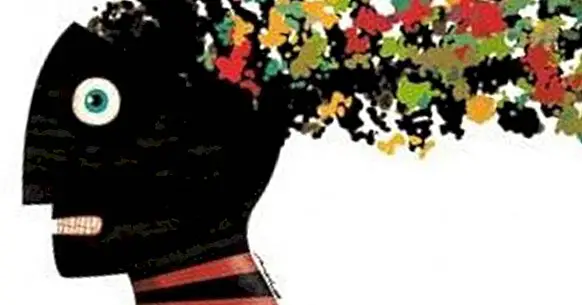Anosognosia: when we do not perceive our disorders
"Pedro suffered a stroke a month ago. Due to this cardiovascular accident, he suffered a hemiplegia that left the left side of his body paralyzed, unable to move the extremities. During a scheduled visit to his doctor, he performs a complete scan, making it clear that Pedro still can not move his left arm and leg. However, Pedro indicates that he does not have any physical problems and that he moves normally, indicating with total conviction that in fact during the exploration he has been doing all the movements that have been indicated correctly. "
This case reflects Peter's belief that his arm is moving normally, there being a clear difference between what he believes he does and his actual performance. We are facing a case of a phenomenon known as anosognosia .
What is anosognosia?
We understand anosognosia as a special subtype of agnosia, in which the patient is unable to recognize the existence of a deficit in functioning even though this may be evident to others. It is a lack of awareness of disease limited to the recognition of one's own deficit, which may be the same individual capable of detecting the same problem in other people.
Anosognosia is not a disorder by itself, but it is cataloged as a symptom, since only appears associated with the existence of a disorder and informs us of its existence .
Although the study of anosognosia in the field of treatment of hemiplegia is very frequent, anosognosia is not limited to this disorder, but it can come from a large number of brain lesions that do not have to be associated solely with the problem of motor system, but also to the perceptual (it is typical to observe its presence in patients with cortical blindness) or other disorders, including psychiatric ones.
Detect anosognosia
In order to diagnose anosognosia it is necessary, in addition to the presence of lack of knowledge of the deficit, that this is denied by the patient, the fact that the deficit is evident in a neuropsychological evaluation, that it is recognized by relatives and relatives and that it supposes a clinically significant interference in the patient's life.
When evaluating this phenomenon it is necessary to take into account that it is necessary to distinguish when the patient really shows anosognosia and when he is making a denial of his problems as a strategy of coping with his loss. Despite this complication, some specific assessment instruments have been created to evaluate anosognosia in which it is requested that the capacity and difficulty to carry out concrete tasks be assessed.
The anosognosia is not an all-or-nothing phenomenon, being able to observe cases in which the disorder is not recognized at any time but also others in which patients recognize the existence of a problem after they are proven to have deficits.
Why is it produced?
Since this phenomenon was called anosognosia by Babinski in 1914, An attempt has been made to explain why this symptom occurs , having multiple theories about it. The explanatory proposals are varied, focusing on the existence of neurological or neuropsychological problems.
An example of this is the theory called Dissociable Interactions and Conscious Experience by Schachter, according to which there is an interaction between the systems responsible for the conscious experience and those of the systems in charge of the deficit function, which, faced with an injury or malfunction, would stop integrating the information correctly, producing a conscious experience of performance or functionality when it is not given from the affected system.
Despite these generalities, the specific cause of the anosognosia will depend on the type and location of the lesion and the problem that causes it.
Some paintings in which it is produced
As already mentioned, anosognosia is a symptom present in very diverse problems. Some of them are the following:
1. Hemiplegia
One of the disorders where its appearance is more frequent . In these cases, the patient usually believes that he makes movements that he does not actually make, and in fact he has the conscious experience of doing them.
2. Cortical blindness
Many patients who have destroyed the occipital area of the brain or the connections between it and the visual pathways (which prevents visual perception), insist that they are able to see normally, making exhaustive descriptions of what they think they visualize. Also in these cases anosognosia occurs.
3. Lateral Heminegligence
In this disorder, although the subject perceives the totality of the perceptual field, he neglects or does not attend one of the visual hemifields , not attending the opposite party to the hemisphere in which he suffers the injury. It is clearly visible when asked to make copies of drawings: in these cases it only draws one of the halves and "forgets" to fill in the other part located on the other side of an imaginary vertical line. In this context it is frequent that the patient is not aware of his problem, presenting anosognosia
4. Dementia
Although in the initial moments of dementia the patient is usually aware of the presence of their various problems, this knowledge does not occur in all cases or in all dementias . In addition, as the disease progresses and the degenerative process continues its course the individual tends to stop being aware of them.
5. Schizophrenia
In some subtypes of schizophrenia, such as disorganized and catatonic, and especially during the acute phases of the disorder, the patient often does not perceive the presence of their own difficulties, as for example in the case of the use of a disorganized language tangential, derailed or incoherent.
Others
Apart from those exposed here there is a very high number of mental and neurological disorders that present anosognosia, being an important symptom to be taken into account for the treatment of various problems
Effects of this symptom
It must be borne in mind that the presence of this problem can entail serious dangers.
The presence of anosognosia is a difficulty when it comes to following a treatment or performing a rehabilitation of the disorder that causes it. It must be taken into account that for a patient to be involved in their recovery, it is necessary that they be motivated to do so, which is difficult if there is no awareness of the presence of a symptomatology. Thus, patients with anosognosia often underestimate or even deny the need for treatment, making it difficult to adhere to the established prescriptions.
Further, the lack of knowledge of the problem can lead the subject to perform actions that may endanger their integrity and / or that of third parties. An example of this could be an individual with lateral heminegligencia (subjects who only attend a hemifield, being unable to see the left or right side of things for example) or with cortical blindness that truly believes to have their abilities conserved and functional, that they decide Take the car and drive.
Treatment of anosognosia
The treatment of the anosognosia itself is complex . In general, the symptom improves with the treatment of the underlying cause of its onset, be it a mental or neurological disorder. However, at the clinical level, confrontation strategies are used.
In this sense, the confrontation with the existence of deficits must be progressive, introducing little by little the idea of its existence. It is important not only to see the presence of deficits, but also of the difficulties involved in daily life.
Bibliographic references:
- Babinski, J. (1918). Anosognosie. Rev Neurol (Paris). 31: 365-7.
- Baños, R. and Perpiña, C. (2002). Psychopathological exploration. Madrid: Synthesis.
- Belloch, A., Baños, R. and Perpiñá, C. (2008) Psychopathology of perception and imagination. In A. Belloch, B. Sandín and F. Ramos (Eds.) Manual of Psychopathology (2nd edition). Vol I. Madrid: McGraw Hill Interamericana
- Bembibre, J. and Arnedo, M. (2012). Neuropsychology of the dorsolateral prefrontal cortex I. In: M. Arnedo, J. Bembibre and M. Triviño (coord.), Neuropsychology: Through Clinical Cases (pp. 177-188). Madrid: Panamericana Medical Publishing House.
- Bisiach E, Vallar G, Perani D, Papagno C, Berti A (1986). Unawareness of disease following lesions of the right hemisphere: anosognosia for hemiplegia and anosognosia for hemianopia. Neuropsychology 1986; 24 (4): 471-82.
- Orfei, M. D., et al. (2007). Anosognosia for hemiplegia after stroke is a multifaceted phenomenon: A systematic review of the literature. Brain, 130, 3075-3090.
- Ownsworth, T., and Clare, L. (2006). The association between awareness deficits and rehabilitation outcome after acquired brain injury. Clinical Psychology Review, 26, 783-795.
- Prigatano, G. P. (2009). Anosognosia: Clinical and ethical considerations. Current Opinion in Neurology, 22, 606-611.
- Prigatano, G. (2010). The study of anosognosia. Oxford University Press.
- Schachter, D.L. (1992). Consciousness and awareness in memory and amnesia: critical issues. In The Neuropsychology of Consciousness. Milner and Rugg. Academic Press London
- Tremont, G. & Alosco, M.L. (2010). Relationship between cognition and awareness of deficit in mild cognitive impairment. Int J Geriatr Psychiatry.



















